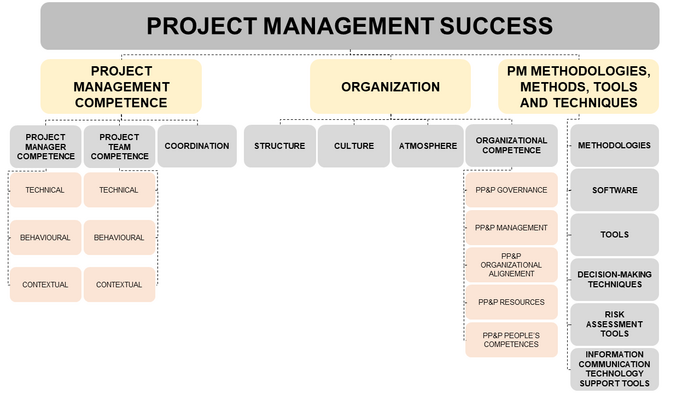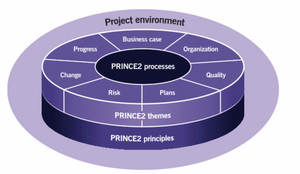Project Management Success Factors
Jonina Thora (Talk | contribs) |
Jonina Thora (Talk | contribs) |
||
| Line 106: | Line 106: | ||
==Limitations== | ==Limitations== | ||
| + | As mentioned earlier, it can be hard to define a firm definition on project success as well as project management success as the success criteria and critical success factors (CSFs) can differ so much from one project to the next one due to a different scope, the uniqueness as well as the overall complexity (Wateridge, 1998). | ||
| + | |||
| + | Project management successfulness is a complex theme, but the benefits gained from the activities of project management are however undeniable. | ||
| + | |||
==Annotated bibliography== | ==Annotated bibliography== | ||
Revision as of 13:20, 16 February 2019
Contents |
Abstract
In the theory of a project, there are two main success concepts: project success and project management success. The project management success does indeed contribute massively to a project but does however not guarantee by itself a successful project (Radujković and Sjekavica, 2017a). Several methods and recommendations regarding successful management of projects have been developed throughout time and it is indeed a complex theme, but the benefits gained in a project from the activities of project management are however undeniable. This article will focus on the success factors of project management as well as discuss how implementing the success factors of project management will increase the odds of a successful overall project.
Big Idea
Project management success may be defined as if an intersection of common understanding of all project objectives has been achieved (Alderman and Ivory, 2011).
As for the definition of “project success”, it is a difficult thing to define. Some authors even presume that readers know what is meant by a “project success” and “project failure”. According to Ika (2009), the only certain thing in project management is that “success is an ambiguous, inclusive and multidimensional concept” and the definition of it relies on the context in each project. The success of a project can also be described with words such as efficiency and effectiveness (Ika, 2009).
The success of a project is related to time, cost and quality performance but the time/cost/quality triangle is better known as the “iron triangle” or the “golden triangle” (Ika, 2009). However, many projects have been delivered within time, cost and quality constraints but are still considered as a failure and at the same time other projects have exceeded the triangle constraints but are still be considered as successful projects (Pinto and Slevin, 1988). Therefore, there is a difference between a successful project and project management success. Most authors agree that a success in a project may be achieved through successful project management.
Project management is focused on project performance, regarding short-term dimensions of project success in which the “iron triangle” is indeed one of the aspects, but a project manager is not only responsible for time, cost and quality management but also integration, scope, human resource, communication, risk and procurement management. The role of a project manager is designed in a way in which fits the organization in the same way that the project management processes are designed to fit the project at each time. This role may vary depending on the type of organization and type of project (PMI, 2017). The success of a project management can thus be evaluated through measurements of time, cost and quality but also scope, resource and activity as well as through models of measuring success like PMPA – Project Management Performance Assessment (Kerzner, 2011).
Critical success factors in project management are defined as levers that a project manager can employ in order to increase the odds of a project becoming successful. (Ika, 2009). Several authors have proposed project management success factors throughout time.
Slevin and Pinto (1988) proposed ten key success factors: project mission, top management support, project schedules/plan, client consultation, personnel, technical tasks, client acceptance, monitoring and feedback, troubleshooting, and communication. These factors are managed by the project team respectfully. They then added 4 additional factors to the list which would not fall into the hands of the project’s team: characteristics of the project team leader, power and politics, environmental events, and urgency.
Radujković and Sjekavica (2017) presented a list of project management parts which contribute both to project management success as well as to the overall success of a project. Those parts are stated to be the project management success factors. They are divided into three categories depending on where their focus lies:
| 1. Elements of project management competence |
|---|
| Total competencies of Project manager |
| Project managers’ emotional intelligence, soft project manager elements |
| Project Manager’s management style |
| Project team members |
| Application of project management knowledge and skills from project manager and project team, as well as their coordination |
| 2. Elements of organization |
| Organizational structure |
| Organizational culture |
| 3. Elements of project management methodologies, methods, tools and techniques |
| Project management tools and technique |
| Project management standards |
| Planning and monitoring software, Request analysis, lessons learned, statement on the scope of project, CPM, CBA, Risk management and contract management. |
The first category consists of technical, behavioural and contextual competencies. The second one has everything to do with the organization, such as organizational structure, organizational culture, organizational atmosphere and organizational competence. The third category consists of six parts: project management methodologies, project management software, project management tools, decision-making techniques, risk assessment tools and information communication technology support tools. The big idea according to Radujković and Sjekavica (2017a) is that “if you have a competent project manager as well as a competent team, coordinated manager and team, adequate organizational structure, culture, atmosphere and competence, as well as high usage of project management methodologies, methods, tools and techniques, your project should have highly successful project management, and enable project success”. One must keep in mind that the importance of these success factors varies depending on the project type that the project management team is dealing with at each time. This may concern whether a project is a public or a private project and what the project’s orientation is as well as the number of projects being managed in organization.
Application
Success-oriented project management can be analysed from two perspectives. The first one is an internal perspective and deals with tools retrieved from the profession of project management in general. The second one deals with the challenges in which the project owner imposes to the project management. A success-oriented project management has to be based on several things such as:
- Requirements specified by the project owner concerning the success of the project.
- Regulations and standards which comply to the type and location of a project at each time.
- Competences of the project management in which comply with the success criteria.
- Satisfied stakeholders and project owner who pin-point their goals and interests throughout the process.
- Documentation of all project management activities.
- Constant monitoring of the project as well as good control of risks and any type of changes or constraints.
(Radujković and Sjekavica, 2017b).
Several methods have been developed through time for managing projects. One of them and probably the most widely used is the PRINCE2 (Projects IN Controlled Environments) method. The method is based on experience contained from thousands of different projects all over the world. The method can be applied to any project no matter the type, size, location etc. The method’s structure is divided into four integrated elements:
- Principles which are the guiding obligations and good practices. There are 7 principles and all of them need to be applied in order for a project to be a certified PRINCE2 project.
- Themes which describe aspects of project managements and must be addressed throughout the project.
- Processes where the progression from the pre-project activity of getting started is described.
- Project environment in which is created in order for organizations to tailor PRINCE2 to create their own project management method.
The seven PRINCE2 principles are:
- Continued business justification – there needs to be a valid reason for starting the project in the beginning.
- Learn from experience – takes place in the beginning of the project phase, in which teams should review similar previous projects, as the project progresses as well as when the project closes.
- Defined roles and responsibilities – right people with right roles are more likely to lead a project to success.
- Manage by stages – in which the project is broken into management stages.
- Manage by exception – setting tolerances against six aspects of performance: cost, time, quality, scope, benefits and risk.
- Focus on products – the quality requirements of products.
Tailor to suit the project – PRINCE2 takes into account that projects may vary from type to type regarding size, complexity, importance, team, capability and risk. (Axelos, 2017). Projects will always be exposed by risks, constraints and changes and if it weren’t for these three factors, project management would overall be so much simpler in many ways. Therefore, an important thing in order to perform successful project management is a continuous management of project-related risks, changes and constraints. Therefore, it is recommended for a project manager and his/hers team to have a work plan in which they document all activities that have been and need to be done. This plan is called “the project management document” or the “project management concept paper”. The document is to be prepared prior to the beginning of each project and is updated throughout the whole project when each individual task has been performed. Radujković and Sjekavica (2017b) recommend the following structure of the document:
- General information about the project
- Business case
- Brief description of the project objectives. What are the needs or wishes of the project owner? Which problems are likely to arise and need to be solved?
- Goal and scope of the project including project deliverables.
- Clear hierarchy of components forming the deliverables (WBS).
- Individual competencies, roles and responsibilities (OBS) of each project management team member.
- Organisational structure, roles and responsibilities as well as decision-making of the project.
- Stakeholder management plan, project participants.
- Time-schedule with main milestones defined.
- Cost plan and cash flow of the project.
- Procurement plan including engagement of suppliers and contractors.
- Risk management plan and analysis of key project risks.
- Administration and approval of changes in the project.
- Analysis of constraints that might delay the project.
- Project management tools to be applied in the project.
- Define international standards when relevant in each project.
- Discuss similar projects in which can be used as a role-model identifying best practice examples.
- Methods for monitoring and controlling the realisation of the project.
- Clear communication methods. How to solve conflicts if needed?
- Use of technological tools in the project management.
- Procedures of project, starting phase to closure.
- Project administering and documenting procedures.
- Other, as needed in each project as they vary from type to type.
Limitations
As mentioned earlier, it can be hard to define a firm definition on project success as well as project management success as the success criteria and critical success factors (CSFs) can differ so much from one project to the next one due to a different scope, the uniqueness as well as the overall complexity (Wateridge, 1998).
Project management successfulness is a complex theme, but the benefits gained from the activities of project management are however undeniable.

